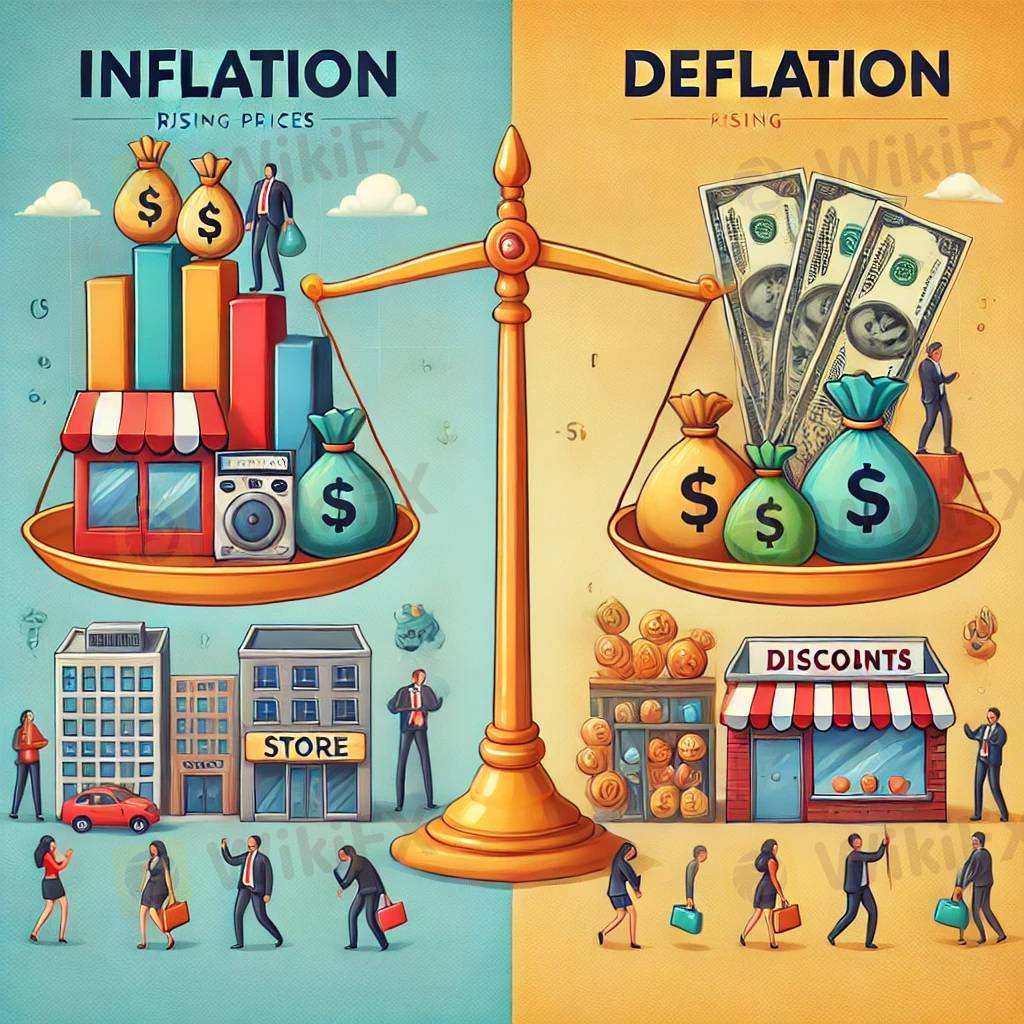
2025-02-13 15:36
IndustryInflation vs. Deflation: Economic Impacts
#firstdealofthenewyearastylz
Inflation and deflation are two opposing economic phenomena, each with distinct causes, consequences, and impacts on economies. Here's a comparison of their effects:
Inflation
Inflation is the sustained increase in the general price level of goods and services over time.
Economic Impacts of Inflation:
1. Decreased Purchasing Power: As prices rise, the value of money decreases, reducing the purchasing power of consumers, especially those on fixed incomes.
2. Redistribution of Wealth: Inflation benefits borrowers (as debts are repaid with devalued money) and harms savers (as the value of savings erodes).
3. Encouragement of Spending and Investment: Moderate inflation may encourage spending and investment, as people anticipate higher prices in the future.
4. Erosion of Savings: High inflation discourages saving due to the loss of value over time.
5. Uncertainty for Businesses: Rapid or unpredictable inflation makes planning and investment more difficult for businesses.
6. Impact on Interest Rates: Central banks often raise interest rates to combat inflation, increasing borrowing costs and potentially slowing economic growth.
When Inflation is Beneficial:
Moderate inflation (typically 2-3%) is often seen as a sign of a healthy, growing economy, providing incentives for production and reducing the risk of deflation.
---
Deflation
Deflation is the sustained decrease in the general price level of goods and services over time.
Economic Impacts of Deflation:
1. Increased Purchasing Power: Consumers benefit from falling prices, but this can lead to delayed purchases as people expect further price drops.
2. Debt Burden Increases: As the value of money rises, the real value of debt increases, making it harder for borrowers to repay.
3. Reduced Consumer Spending: Deflation creates a cycle where consumers and businesses delay spending and investment, leading to reduced demand.
4. Economic Contraction: Declining demand can lead to lower production, rising unemployment, and slower economic growth.
5. Business Profitability Declines: Falling prices squeeze business revenues and profits, leading to layoffs and reduced economic activity.
6. Central Bank Challenges: Traditional monetary policy tools, like lowering interest rates, may become ineffective, as seen in deflationary spirals (e.g., during the Great Depression or Japan's "Lost Decade").
When Deflation Occurs:
Deflation is typically associated with economic crises or periods of weak demand, often triggered by reduced consumer spending or tightening credit conditions.
---
Key Differences:
---
Conclusion
Inflation: Moderate inflation is often a sign of economic growth but must be controlled to prevent hyperinflation or economic instability.
Deflation: Persistent deflation is a warning sign of economic distress and can lead to prolonged stagnation or recession.
Both scenarios highlight the importance of balanced monetary and fiscal policies to maintain price stability and sustainable economic growth.
Like 0

Sistmeg
Broker
Hot content
Industry
Event-A comment a day,Keep rewards worthy up to$27
Industry
Nigeria Event Giveaway-Win₦5000 Mobilephone Credit
Industry
Nigeria Event Giveaway-Win ₦2500 MobilePhoneCredit
Industry
South Africa Event-Come&Win 240ZAR Phone Credit
Industry
Nigeria Event-Discuss Forex&Win2500NGN PhoneCredit
Industry
[Nigeria Event]Discuss&win 2500 Naira Phone Credit
Forum category

Platform

Exhibition

Agent

Recruitment

EA

Industry

Market

Index
Inflation vs. Deflation: Economic Impacts
 Hong Kong | 2025-02-13 15:36
Hong Kong | 2025-02-13 15:36#firstdealofthenewyearastylz
Inflation and deflation are two opposing economic phenomena, each with distinct causes, consequences, and impacts on economies. Here's a comparison of their effects:
Inflation
Inflation is the sustained increase in the general price level of goods and services over time.
Economic Impacts of Inflation:
1. Decreased Purchasing Power: As prices rise, the value of money decreases, reducing the purchasing power of consumers, especially those on fixed incomes.
2. Redistribution of Wealth: Inflation benefits borrowers (as debts are repaid with devalued money) and harms savers (as the value of savings erodes).
3. Encouragement of Spending and Investment: Moderate inflation may encourage spending and investment, as people anticipate higher prices in the future.
4. Erosion of Savings: High inflation discourages saving due to the loss of value over time.
5. Uncertainty for Businesses: Rapid or unpredictable inflation makes planning and investment more difficult for businesses.
6. Impact on Interest Rates: Central banks often raise interest rates to combat inflation, increasing borrowing costs and potentially slowing economic growth.
When Inflation is Beneficial:
Moderate inflation (typically 2-3%) is often seen as a sign of a healthy, growing economy, providing incentives for production and reducing the risk of deflation.
---
Deflation
Deflation is the sustained decrease in the general price level of goods and services over time.
Economic Impacts of Deflation:
1. Increased Purchasing Power: Consumers benefit from falling prices, but this can lead to delayed purchases as people expect further price drops.
2. Debt Burden Increases: As the value of money rises, the real value of debt increases, making it harder for borrowers to repay.
3. Reduced Consumer Spending: Deflation creates a cycle where consumers and businesses delay spending and investment, leading to reduced demand.
4. Economic Contraction: Declining demand can lead to lower production, rising unemployment, and slower economic growth.
5. Business Profitability Declines: Falling prices squeeze business revenues and profits, leading to layoffs and reduced economic activity.
6. Central Bank Challenges: Traditional monetary policy tools, like lowering interest rates, may become ineffective, as seen in deflationary spirals (e.g., during the Great Depression or Japan's "Lost Decade").
When Deflation Occurs:
Deflation is typically associated with economic crises or periods of weak demand, often triggered by reduced consumer spending or tightening credit conditions.
---
Key Differences:
---
Conclusion
Inflation: Moderate inflation is often a sign of economic growth but must be controlled to prevent hyperinflation or economic instability.
Deflation: Persistent deflation is a warning sign of economic distress and can lead to prolonged stagnation or recession.
Both scenarios highlight the importance of balanced monetary and fiscal policies to maintain price stability and sustainable economic growth.
Like 0
I want to comment, too
Submit
0Comments

There is no comment yet. Make the first one.

Submit
There is no comment yet. Make the first one.